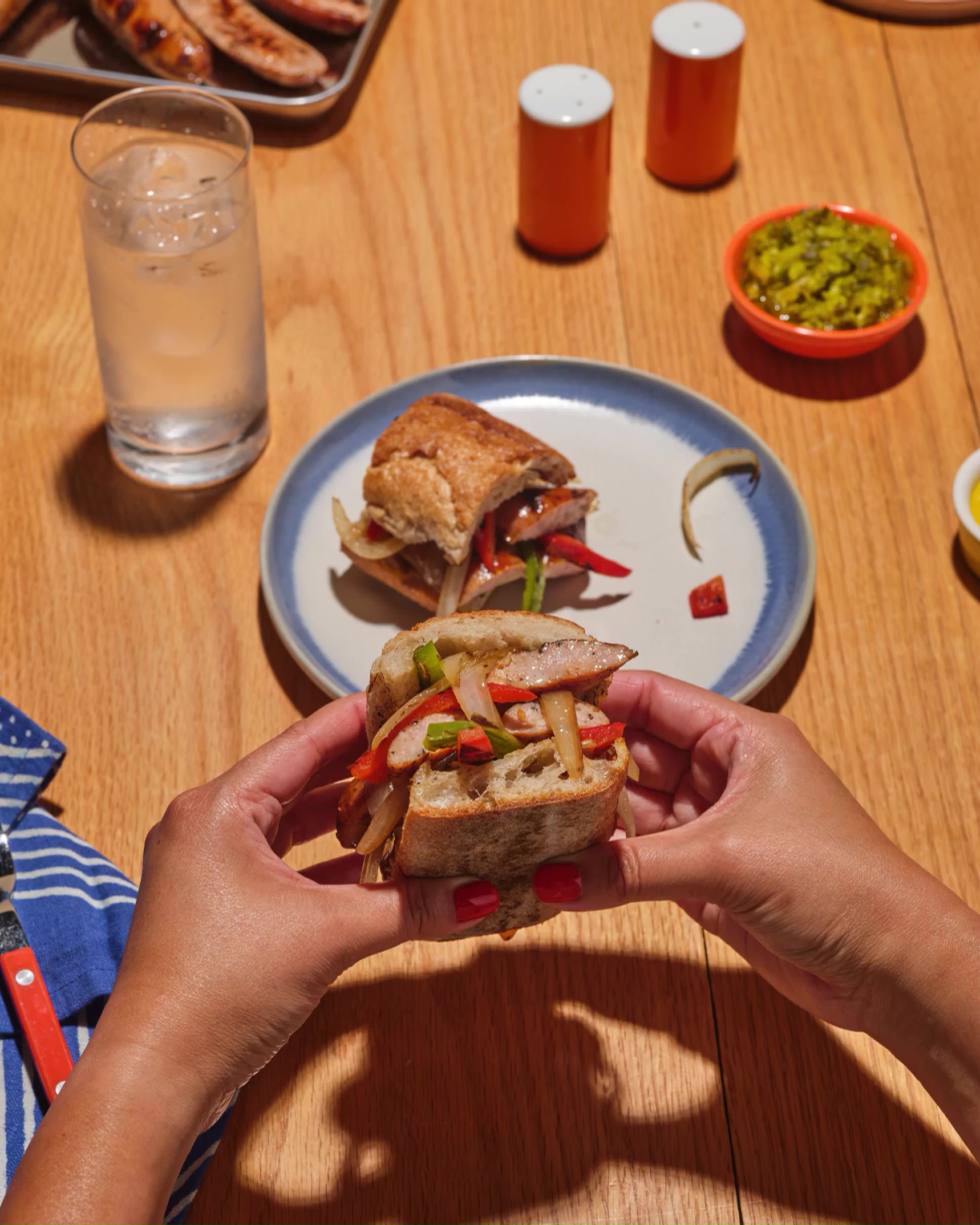
When you bite into a sausage with a natural casing, a magical chain reaction occurs.
First, your teeth break through the outer fibers, sometimes with an audible pop. Then, protein-packed juices flood wash over your mouth. Concentrated salt and spices hit your taste buds and aromatics fill your nose. And then, your eyes close. You breathe deep, exhale. Chew, swallow. Dopamine rushes through your brain.
Oftentimes, when we think about a delectable dish, we think only about the flavor and appearance. But eating is an extrasensory experience. Some foods are a glorious collaboration between texture, sound, and flavor, hitting you hard in the mouth without you even realizing why. Sausages are one such food. That’s why the chefs behind The Sausage Project were deeply intentional with every ingredient when developing their signature links. One of the top priorities setting these chicken sausages apart? Making a great first impression from the moment you chomp in. Which made snappy natural casings a no brainer.
But why is it so satisfying to bite into a juicy sausage? Turns out, your brain is hardwired to love that dopamine-inducing snap—and science can prove it.
Why That Snap Sounds So Satisfying
According to food scientist Dr. Bryan Quoc Le, the pop of a sausage plays a bigger role in how food tastes than you might realize. Your hearing, the physical sensation, and your taste receptors all communicate. The sounds your food makes—crunching, fizzing, and crackling—impact perception. So the snapping sound actually makes the sausage more delicious. Research also shows that “loud noises or strong pressure in your mouth enhances umami,” Dr. Le says.
A 2016 study tested whether adding artificial crunchy sounds to soft nursing home foods would change how people perceived them. When researchers played "crunchy" sounds while people ate soft foods, participants rated the same foods as significantly more satisfying.
This craving for crunch is psychological, sure, but it’s also primal wiring. When you chomp down on a sausage’s crisp exterior and meat liquor fills your mouth, your brain interprets the contrasts as a sign of good nutrition, which makes you feel good.
Unlike, say, pandas, who only eat bamboo, humans evolved to enjoy a wide-ranging diet. Dr. Le explains that different textures signal to our brains that we’re getting a variety of nutrients, like protein, fat, and fiber. Audible and tactile eating is also linked to happiness: A NASA study found that when astronauts ate one texture and one flavor, they got depressed, indicating that we’re hardwired to be bored and sad by monotony on our plates.

Natural vs Synthetic Casings: What’s the Real Difference
But where does the celebratory sausage sound come from? Natural casings—typically pork-based, as with The Sausage Project, but also using sheep products— are made up of multiple types of connective tissues, or “long linear chains,” as Dr. Lee describes them. Think of them as fancy high thread count sheets wrapping your chicken sausage. As you bite down, your teeth encounter different materials of different strengths. Each layer resists a little and then breaks apart, creating that supremely pleasurable snap that you can both see and feel.
Synthetic casings, meanwhile, are usually made from just one or two basic materials like cellulose or collagen, so your teeth cut right through them without sound. In developing The Sausage Project, Chef Kirk Gilbert says that combination of synthetic ingredients and dull texture made non-natural casing a non-starter.
“You can’t replicate the snap you get from a natural pork casing with a synthetic one,” says Chef Kirk. “Plus, they split when you cook them. It’s just a sad tradeoff in quality.”
The differences go beyond sound and how they handle heat, too. Natural casings contain amino acids and trace minerals your body can use, while synthetic casings, particularly those made from cellulose, are essentially just fiber that passes through your digestive system.
There’s also the processing factor. Synthetic casings often undergo extensive chemical treatment like bleaching and contain additives. While the health impacts vary depending on the product, the general principle holds that fewer processing steps typically means fewer additives.
Synthetic casings simply can't compete with nature’s meaty answer to a popping champagne bottle. Chef Kirk summarizes the superior experience of eating a sausage with a natural casing succinctly: “When you get that bite—where it’s juicy, and it snaps between your teeth, and some of the juice pops out… that’s so rewarding.”
Science and your brain agree.